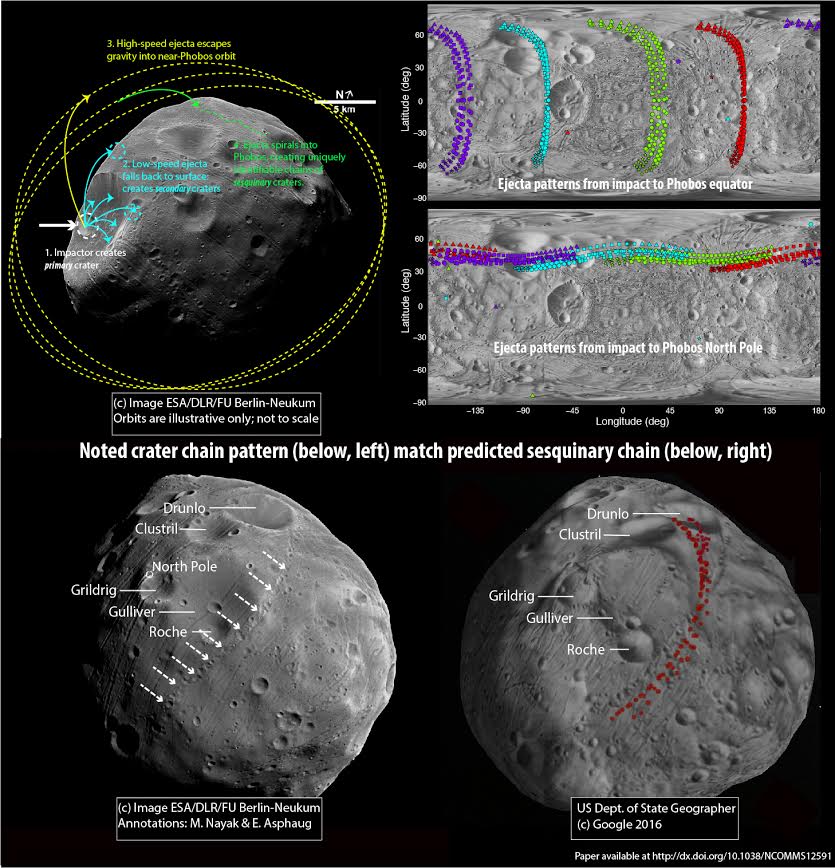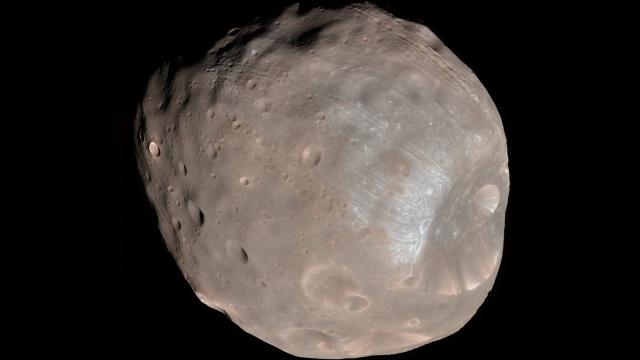Phobos just can’t catch a break. Not only is Mars’ lumpy, crusted-over dust bunny of a moon destined to be ripped to pieces in 10 million years, it seems the poor thing can’t stop punching itself.
Phobos, beloved by no one. Image: Wikimedia
Not literally, of course. But it appears that a series of mysterious scars and crater chains on the battered Martian moon of Phobos are self-inflicted. That’s according to new computer models published today in Nature Communications, which show how these features are produced when escaped chunks of Phobos rain back down the surface.
Since NASA’s Viking spacecraft snapped the first close-up photos of Phobos in the 1970s, scientists have puzzled over a motley collection of markings on the tiny Martian moon. At first, the features were taken to be tidal scars caused by the gravitational tug of the Red Planet slowly reeling Phobos in toward a spectacular death.
But as more spacecraft acquired images of Phobos, astronomers discovered a fainter, second family of scars, resembling the indentations caused by a golf ball skipping across sand. “These [features] cross-cut the stress field for tides,” lead study author Mikey Nayak told Gizmodo. “People realised some other forces must be at play.”

Mysterious crater chains criss-cross the surface on Mars’ moon Phobos. In this illustration, Nayak shows how ejected material can re-impact the surface of Phobos (top left) and produce distinct linear chains (top right). One prominent crater chain that was inexplicable with tidal models (bottom left) can be explained via these repeated impacts (bottom right). Image: M. Nayak
Now, Nayak has discovered a solution to the longstanding mystery, by modelling what happens when comets or asteroids strike the moon, causing chunks of Phobos to be flung off into space. “Phobos circles Mars every seven hours, so the chances of it being impacted by something from the asteroid belt are fairly high,” Nayak said. “Our models show that after stuff gets kicked off, it goes into orbit. In a matter of days or weeks later, it falls back.”
According to Nayak, this process of repeated, self-inflicted injury is a relatively recent phenomenon for Phobos. His models show that when the moon was in a higher orbit, ejected material would have had more time to disperse before returning to the surface, and it wouldn’t have formed distinct linear chains when it did. “We think this process started when Phobos crossed the Roche limit about 10 million years ago,” Nayak said, referring to the theoretical point at which a moon should be pulled apart by the gravitational tug of its planet.
That’s good news from a scientific perspective, because geologically younger markings are easier to date. Nayak hopes that in the future, all of Phobos’ craters can be mapped and dated at a high resolution, allowing astronomers to reconstruct the moon’s history in detail.
There are still many open questions about this strange, doomed moon. Did it form in place during a giant impact, or is it a captured asteroid? When it disintegrates, will it produce a spectacular ring? Is Phobos an abandoned alien spacecraft, or a fossilised Cadbury egg? In that ruddy, battered surface, the answers are waiting.
